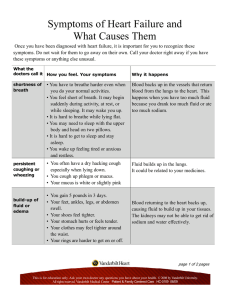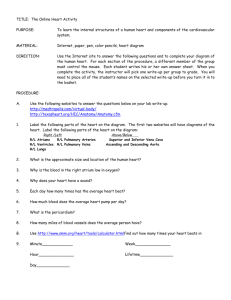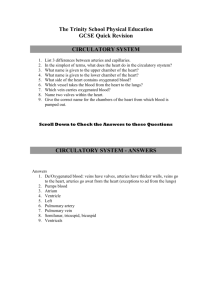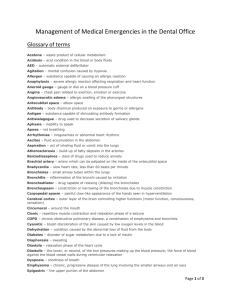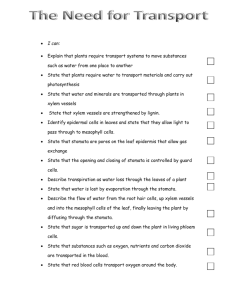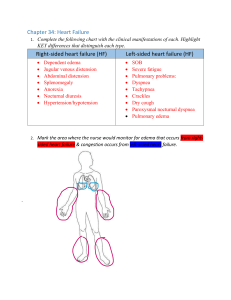Diseases of the Heart Anatomy The Circulatory System
advertisement
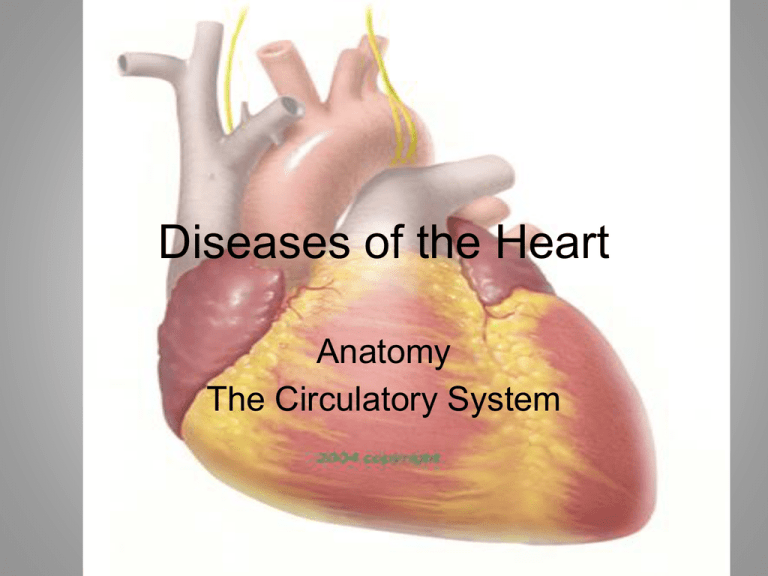
Diseases of the Heart Anatomy The Circulatory System Arrhythmia •Abnormal heart rhythm •Irregular heartbeats and heart rates Bradyarrhythmia • Bradycardia – heart rates that are slow (less than 60bpm) • Caused by decreased body temperature or certain drugs • May occur during sleep or some athletes have unusually slow heartbeats • Treatment – medicines, pacemaker, surgery Tachyarrhythmia • Tachycardia – rapid heart rate (faster than 100 bpm) • Caused by an increase in body temperature, drugs or hormones, heart disease, excitement, exercise, anemia, or shock • Treated by medicine, pacemaker, surgery Fibrillation • Small areas of the myocardium contract in an uncoordinated, chaotic fashion (shuddering) • The myocardium fails to contract as a whole, and blood is no longer pumped • Occurs in both the atria and ventricles (deadly) • Caused by an obstructed coronary artery, toxic drug exposure, electric shock, or traumatic injury to the heart or chest wall • Treated by medicine, electrical procedures Hypertension • High blood pressure – persistently elevated arterial pressure • “Silent Killer” • Can lead to a heart attack, stroke, atherosclerosis • Caused by poor diet, high sodium intake, stress, obesity, lack of physical activity, genetics, older age, smoking, alcohol • Treatment includes exercise, controlling weight, reducing stress, limiting sodium, medicine Hypertension • Prehypertension – blood pressure is consistently just above normal (120-139 & 80-89) • Hypertension – consistently 140/90 Atherosclerosis • Usual cause of heart attacks, strokes, and aneurysms • High blood pressure, a fatty diet, smoking, obesity, genetic factors, and lack of exercise damage the endothelium (lines the arteries) & cholesterol plaque forms • The arteries harden and narrow and block blood flow • Treated by lifestyle changes, medicines, or surgeries Heart Attack/Myocardial Infarction • Part of the coronary circulation becomes blocked, and cardiac muscle cells die from lack of oxygen • Coronary heart disease causes the arteries to become narrow and blood cannot flow as well • Fatty matter, calcium, proteins, and inflammatory cells build up within the arteries to form plaque Heart attack continued • When the plaque that forms becomes hard, the outer shell cracks, and blood clots form around the plaque • If a blood clot blocks the artery, the heart muscle becomes “starved” for oxygen • Within a short time, death of heart muscle cells occurs, causing permanent damage Risk Factors of a Heart Attack 1. Smoking 2. High blood pressure 3. High blood cholesterol levels 4. Diabetes 5. Obesity 6. Sedentary lifestyle 7. Genetics Treatments – immediate medical attention, drugs, surgeries Pulmonary Edema • The lungs fill with fluid due to a failing left ventricle or damaged mitral (bicuspid) valve • Causes blood to back up into the pulmonary circuit and pressure to increase in the capillaries in the lungs, flooding the spaces with fluid • The fluid interrupts normal oxygen movement in the lungs • Treatments include aspiration, medicine, surgery Pulmonary Edema • An abnormal buildup of fluid in the air sacs of the lungs, which leads to shortness of breath • In most cases heart problems cause pulmonary edema but fluid can accumulate for other reasons • As pressure in the blood vessels increase, fluid is pushed into the air spaces (alveoli) in the lungs • This fluid interrupts normal oxygen movement in the lungs
